In order for the dishwasher to be able to wash the dishes, it is necessary to load a special washing powder, salt and rinse aid into it. All these components provide flawless laundering of kitchen utensils. Dishwasher rinse aid is an essential component of any sink.. Without it, it is impossible to achieve decent results and high-quality drying work. We will talk about how this tool works in our review.
Why you need dishwasher rinse aid
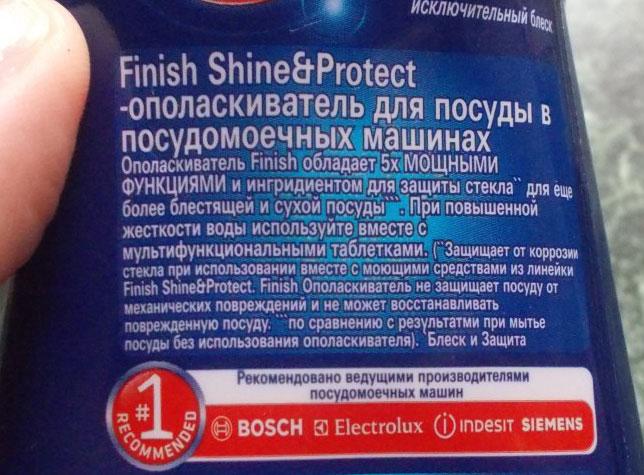
Many users doubt whether rinse aid is needed in the dishwasher. With the same success, one can doubt whether a machine needs engine oil - without it, the engine can fail in the first minutes of operation. As for the dishwasher, here the rinse aid performs several important functions:
- Provides flushing of powder residues into the sewer;
- Gives dishes extra shine;
- Helps to remove water from the surface of kitchen utensils.
If washing in the dishwasher is carried out using rinse aid, the surface of the dried dishes will creak from its own cleanliness.
In order to understand why rinse aid is needed, you should familiarize yourself with dishwasher operation principle. It lacks a kind of mechanical hand that rubs a sponge with detergent on each saucer. During washing, all objects remain completely motionless - they do not spin, do not move, do not move from place to place. There are also no mechanical contacts of any moving parts of the machine with the dishes.
Washing is carried out by hard jets of water with a detergent dissolved in it.The jets break out of the rotating rocker arms, which ensures their contact with all objects loaded into the working chamber. Due to the high speed of water release, it washes away all dirt from the surface of cups and plates. And the dissolved powders or gels, which are highly effective, help her in this.
As soon as the dishwasher finishes washing the dishes, the pre-rinse begins - the last dirt and detergent residues are removed from the loaded items. If we remove the dishes from the machine at this point, their surface will be almost clean, but wet. And in the remnants of the water, the remnants of the powder (gel) will be felt. These residues must be removed, as they are quite aggressive.
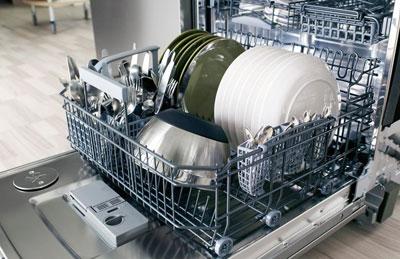
The last stage is the final rinse, which is carried out in hot water with the addition of rinse aid, which finally removes detergent residues from the surface of dishes, neutralizes active additives and other aggressive components. At the same time, the dishes are endowed with hydrophobic properties, which causes the water to flow down almost completely, ensuring normal drying.
Modern conditioners have the following properties:
- Effectively remove residual dirt;
- Remove old stains from glass products;
- Make forks and spoons shine;
- Protect the inside of the dishwasher from limescale;
- Eliminate smudges on the surface of dishes.
That is, these are multifunctional products that take care not only of kitchen utensils, but also of dishwashers.
Types of rinse aids for dishwashers
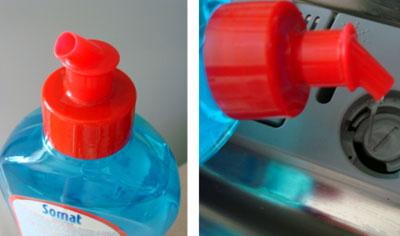
If you are going to buy a dishwasher rinse aid, but are in doubt about your choice, we recommend that you familiarize yourself with the most popular products. They can be:
- Simple - perform a minimum of functions, cleaning glasses, cups, plates and cutlery;
- Multifunctional (up to 5-6 useful actions) - provide additional care for equipment;
- With and without smell - the latter are aimed at those who cannot tolerate the strong aromas of household chemicals;
- Environmentally friendly, hypoallergenic - for those who suffer from allergies and do not like aggressive chemicals.
Respectively, the more useful properties the conditioner has, the higher its price. Let's take a few products as an example.
Rinse aid from a well-known manufacturer chemicals for dishwashers Somat - its estimated price is 190-200 rubles. for a 750 ml bottle. This is one of the cheapest means, but it is highly effective. The manufacturer is quite well-known, its products are appreciated by many consumers. The presented rinse aid provides excellent drying performance, eliminates lime stains, and makes glass shine.
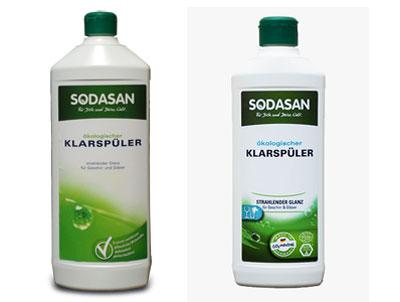
Finish Rinse is a product from one of the leading brands. A 400 ml bottle will cost you about 260-290 rubles.The cost is higher than the previous sample, but Finish products allow you to achieve simply excellent results. The manufacturer recommends using in conjunction with this rinse and other Finish for dishwashersmanufactured under their own brand.
The environmentally friendly Sodasan rinse is aimed at those who do not tolerate caustic chemicals or suffer from allergies.. Its composition is extremely simple - it is water, citric acid, a little alcohol and essential oils. There are no surfactants in it, so it can be used to wash children's dishes. True, for a half-liter bottle you will have to pay almost 500 rubles - a little expensive, but safe.
How much rinse aid to pour into the dishwasher
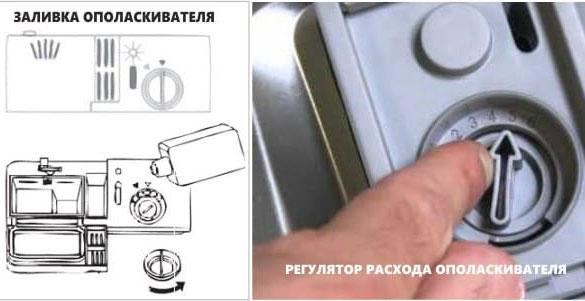
If you have already bought a dishwasher rinse aid, it's time to start testing. To do this, pour it into the dishwasher. The most common mistake is adding the product directly to the tank or to the powder (gel). To do so is not something that cannot be done - to do so is useless. The rinse aid should start working after the pre-rinse, and not with detergent - otherwise there will be no sense from it.
Next, let's look at the quantity. Many users do not know that dishwashers can dispense rinse aid on their own. Therefore, it must be poured not a little bit, but pour as much as will fit into a special compartment (located approximately in the same place as the detergent tray). Pour the rinse aid into the dishwasher and set its consumption as indicated in the instruction manual.
How to replace dishwasher rinse aid

Not everyone knows that you can make your own dishwasher rinse aid. Here's what it's for:
- If an allergy occurs when using factory-made preparations;
- To reduce the cost of household chemicals;
- To protect yourself from the chemical components of modern products.
Most often, people tend to save money - not everyone is ready to pay as much as 500 rubles for a bottle of a safe product.
To make a simple rinse aid, we need a liter of water in which we need to dissolve a small amount of citric acid (it costs 60-70 rubles per 1 kg, enough for a whole barrel of rinse aid), a couple of tablespoons of alcohol and any essential oil (sold in a pharmacy). If you want to do without smell, you can not add oil. Pour the finished rinse aid into the appropriate dispenser of the dishwasher.
We will build the second tool on any glass cleaner, lemon juice (you can use a solution of citric acid) and essential oil - the juice is mixed with the glass cleaner in a ratio of 5 to 1, the amount of oil is a few drops. Pour the finished rinse aid into the dishwasher and start the next cycle.
In the simplest case you can use apple cider vinegar. Some people claim that ordinary table vinegar will do, but it does not have a very pleasant smell.Therefore, it is best to make a homemade preparation based on lemon.But we do not recommend using glass cleaners - some of them are more dangerous than any other store rinses.
